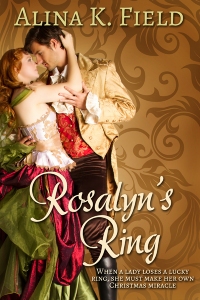
Writing Outside the Box - with Storyboxes
Today I'm proud to welcome to WITS a debut historical author, Alina K. Field. You may not have heard of her yet, but trust me, you will! Take it away, Alina!
Thanks to the Writers in the Storm crew for inviting me today.
You’ve probably heard of “thinking outside the box.” For many years I worked in a highly structured, byzantine business culture. “Thinking outside the box” was a pleasant activity for team-building days, but my sad, cynical heart knew it wasn’t at all a realistic endeavor in that rule-bound bureaucracy. When I could finally lift the lid, climb out of that particular box, and sit down to fulfill a dream of writing fiction, the great yawning freedom made me giddy.
But what to write? My goals weren’t limited to writing stories; I wanted to sell them as well. The empty page stared back at me.
Embracing the Box
I soon learned that in writing fiction, boxes can be good. Boxes can be liberating. As author Andrew Knighton says, “We underestimate the value of limitations in art. If I sit down without any restrictions, without a word count or a genre to work towards, I can do anything. But that doesn’t give me any focus.”
Last year I took author Laura Baker’s class, The Fearless Writer: Discovering your Story, and learned, among other things, the concept of creating a Story Box. In the simplest terms, a Story Box is a limit, a framework, or a set of specifications for your story.
The conventions of a genre create a story box. The characters and setting of a sequel create a story box. A writing prompt creates the simplest story box.
Laura’s approach is a little more in depth.
From Story Box to Story
I took the results of the first few homework assignments—favored themes and emotions, preferred characters, and conflicts—and zeroed in on an idea I’d been thinking about for some time and, with Laura’s guidance, built a box.
1) I started with a story idea:
A recently retired FBI agent visits a bitter undercover cop's widow to remove the bugs he himself planted in her home, and warn her that someone (the agency, a rogue agent in the agency, a criminal - maybe all three) is seeking something of value that her husband hid from his handlers, as insurance.
Obviously, this is noodling out an idea, not writing a logline!
2) Next, I looked at the list of my compelling themes and emotions and assign one to each of the three main characters:
For the villain—Greed: The villain is seeking money or power.
For the hero—Redemption: The hero is seeking redemption for his inadvertent participation in the villain’s betrayal.
For the heroine—Betrayal: The heroine feels betrayed, possibly by her husband, possibly by the government.
3) Then I looked at premise. What is a premise you ask? In logic, a premise is a proposition helping to support a conclusion. My premise states the conclusion of the story’s conflict:
Seeking redemption defeats betrayal.
(This is a romance. If you’re writing a tragedy, swap the themes.)
4) I defined hero and heroine’s roles in terms of their emotions:
The heroine will show what it looks and feels like to always wonder if people can be trusted.
The hero will show what it looks and feels like to have his trust in his own judgment shaken and to seek to redeem himself for his errors in judgment.
5) I identified some ways in which the roles can create conflict:
The heroine resists the hero’s attempts to communicate with her.
She needs his help to find the truth, but she doesn’t trust him.
This is his personal quest, so he is not always willing to share information with her.
6) I identified what the heroine, the protagonist, must learn:
She learns that by opening up and relying on someone else, she can find the truth, learn to trust, give forgiveness, heal wounds, and find true intimacy with another person.
Was this easy? No. But Laura provided invaluable feedback at every step. It was helpful on more than an intellectual level. When my fingers hit the keyboard, some things changed, but this Story Box was the genesis for my NaNoWriMo project that placed first in the FabFive contest this year! (First contest win; pause for a SQUEE!)
But does a Story Box Have to be Long and Complicated?
Shortly after the Fearless Writing class ended, a friend shared a publisher’s call for submissions for novellas, each one with its own specifications and a deadline that would put a rambling writer like me into cardiac arrest.
I decided to brave the call for a Christmas novella with a three month deadline. Besides the Christmas theme, there were two more must haves: a) a historical setting; and b) a ring that played a central role in the romance.
 Three things: Christmas, historical setting, and a ring; that was the short and sweet Story Box for my new release, Rosalyn’s Ring, pretty much written organically in eighteen days.
Three things: Christmas, historical setting, and a ring; that was the short and sweet Story Box for my new release, Rosalyn’s Ring, pretty much written organically in eighteen days.
Making your own Story Box
If you’re writing genre fiction, you’ve already embraced a framework. And if you’re writing a series about, hmmm, say, biker chicks, or bull riders, you’ve raised the sides of your box a little higher.
But if you’re facing a frighteningly blank page, why not set some specific limits? A compelling theme, a particular setting, a certain prop, a stock character. Restrictions can narrow focus, force us out of our comfort zone, and create new challenges that make us grow.
And for more information on Laura Baker’s approach, visit www.fearlesswriter.com.
How about you? Have you ever found limits or story requirements inspiring? I’d especially love to hear from the absolute pantsers, the folks who set their fingers to the keyboard and ask the muse “what comes next?”
 Alina K. Field earned a Bachelor of Arts Degree in English and German literature, but she found her true passion in reading and writing romance. Though her roots are in the Midwest, after six very, very, very cold years in Chicago, she moved to Southern California and hasn’t looked back. She shares a midcentury home with her husband and a blue-eyed cat who conned his way in for dinner one day and decided the food was too good to leave.
Alina K. Field earned a Bachelor of Arts Degree in English and German literature, but she found her true passion in reading and writing romance. Though her roots are in the Midwest, after six very, very, very cold years in Chicago, she moved to Southern California and hasn’t looked back. She shares a midcentury home with her husband and a blue-eyed cat who conned his way in for dinner one day and decided the food was too good to leave.
Visit her at AlinaKField.com.
17 comments on “Writing Outside the Box - with Storyboxes”
Subscribe to WITS
Recent Posts
- 5 Home Defense Techniques for Any Character
- The Torment and Bliss of the Crappy First Draft
- 4 Story Moments that Don’t Need Conflict
- Author Affirmations for the Editing Phase
- Writing Fast or Slow, Deep Editing is the Way to Go!



Great post, Alina and Laura. I look forward to checking out Alina's work. Taking this post and pasting in my reference notebook! Thanks, ladies.
Thanks, Catherine!
Alina, I am an almost total pantser. And yet, I do this informally in my head before I start a book. I know the heroine's baggage that she has to overcome, and the 'theme' (ie forgiveness, facing demons, learning to trust, etc.) and the rest comes from that.
I would never have thought that I was 'writing in the box,' but I guess I am! Thanks for teaching me something this morning!
Hi, Laura. Figuring out a process that works for your muse is half the battle!
Yeah, but the problem is, my muse is a cranky old broad, smoking a stogie, and giving me the finger!
A stogie! LOL! Mine doesn't smoke, but she's an OCD perfectionist.
Great post. This box sounds like something I need to investigate. I face the blank page regularly and it terrifies and frustrates. I think I do need a framework.
Hi, Trinity. That Blank Page Panic is indeed a terrible thing!
Alina, I think my muse is the kissing cousin to Laura's muse ... smoke hanging out the corner of her mouth and a smirk on her face. "Yeah, like I'm going to listen to you."
Okay, even though I am also a panster ... I can see the true value of this type of approach. It's good to wake up on Monday am and find something new to learn. Thanks 🙂
I'm always looking for new approaches also. Darn, where's that autopen that writes the story for me?!
Great post! I had never thought of my process as story boxing. Actually, my process is like a box within a box within a box into infinity. My muse needs to get the poker out of her butt and let go a little!
No, I know you, Barb - your problem isn't your Muse - it's that danged internal editor! Kill the witch....it's legal, I swear.
I agree with what Laura said! You're a darn good writer. Tell that internal editor to take off the Muse costume.
Thanks for the blog. I see the boxes as good way to make sure I have CMA, um covered all basis. 🙂 I think outside the box could actually pertain to story plot, that is something out of the realm of the normal or same ol' same ol'. I know there are only so many plots but it's the outside of the box ideas that make them new. 🙂
That's a good way to look at it!
[…] K. Field: Writing Outside the Box – with Storyboxes. Excerpt: “You’ve probably heard of “thinking outside the box.” For many years I […]
[…] Story boxes […]